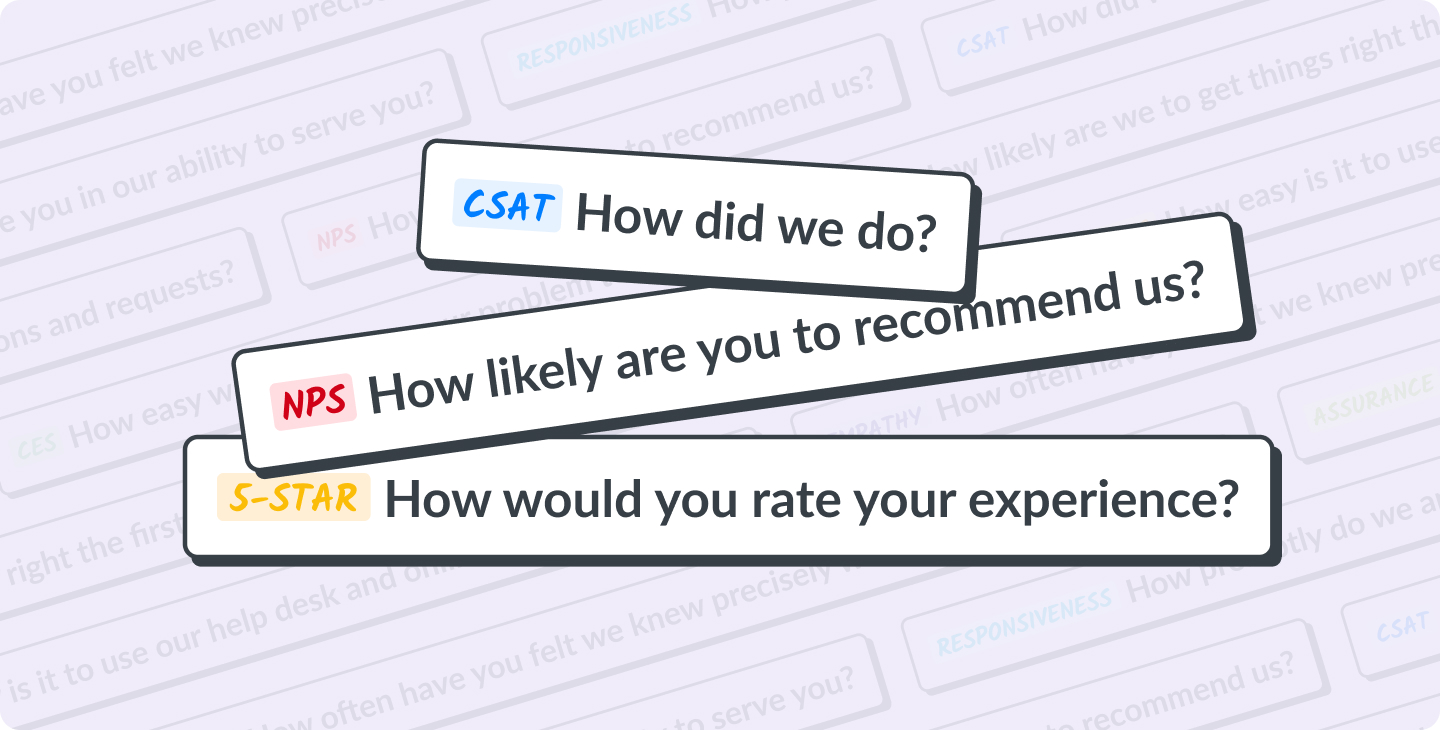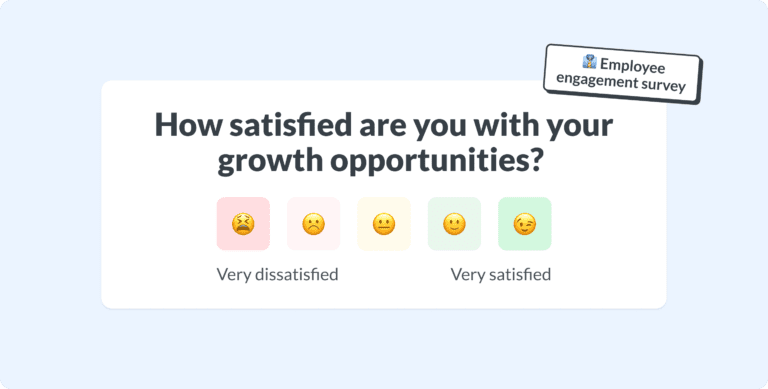Your customers hold the key to your success as a business.
What do they value most in your product or service? What improvements do you need to focus on first? Is there some major flaw that you and your team have been missing all this time?
Your customers are happy to tell you! But you have to learn to ask the right questions.
What makes a good customer survey?
When it comes to customer satisfaction feedback, high response rates are obviously better.
The more data you have to work with, the clearer idea you get of your brand.
But you also need top-quality data, which means keeping your own biases out of the questions you ask.
As a rule, you get good information when your surveys are:
- Short and clear. Don’t confuse the customer, and be mindful of language barriers.
- Relevant to the customer. The customer wants to know that their opinion is valued. That means you tailor the question to the respondent: personalize it and take into account where they are in their customer journey.
- Objective. Avoid leading or loaded language.
- Flexible. If a customer wants to skip a question but can’t, they might leave a random or deliberately misleading response. Make sure they can skip questions that don’t apply to them (and avoid too-personal questions in general).
- Contextualized. Make sure the customer understands what the survey is for.
Every survey needs a clear goal. If you want to capture the customer’s immediate reaction to a service you provide, it’s best to stick to just one or two questions.
But for a more comprehensive impression of your brand, use multi-question surveys with conditional logic.
Depending on response options, there are:
- Closed-ended surveys, where you determine a selection of answers for the respondent to choose from (for example, yes/no questions, questions with a 1-5 scale, etc.)
- Open-ended surveys which allow the respondent to explain their response in their own words.
Closed-ended questions form the backbone of your survey: they give numerical results you can use in calculations and track over time. But adding an open-ended follow-up question can be just what you need to reach excellence.
Top customer survey questions for CSAT, NPS, and more
Service metrics provide a numerical rating you can use to quantify individual or aggregate feedback. Learn more in our beginner’s guide.
Choosing which metric to use depends on your industry, your relationship with the customer, when and how you’re sharing the survey, etc. But regardless of which survey type you use, each starts with a simple, closed-ended question.
CSAT survey
Usually sent immediately after closing a ticket, CSAT survey questions are used to measure a customer’s satisfaction with a specific event or agent.
CSAT survey results help customer service managers coach their teams or implement transparent systems where agents can quickly identify their own areas for improvement.
It can be a great idea to share CSAT results with your team automatically as a source of motivation.
CSAT question:
👀 How did we do on this request?
- 😡 Terribly disappointing
- 😞 Bad, I’m unsatisfied
- 😐 Okay, but not great
- 🙂 Great, I’m satisfied
- 😍 Absolutely amazing!
Follow-up questions (with conditional logic):
- Was there anything in particular we did that delighted you? (if positive)
- Can you share your experience and how we could have done a little better? (if neutral)
- We’re sorry to have let you down, how could we improve? (if negative)
More CSAT question examples:
- Please rate the support you received!
- Follow-up: Is there anything you’d like us to know about this service/product/interaction?
- Did you find our FAQ helpful?
- Follow-up: What would you change about our FAQ?
- Did we provide all the information you needed to use our service?
- Were you satisfied with the time it took for your issue to be resolved?

NPS survey example
Usually sent on a recurring basis, NPS surveys measure customer loyalty.
These surveys are often sent out on a quarterly or yearly basis. The goal is to help you understand how your clients feel about your business. You can also share an NPS survey when you release a new product, or as a part of your offboarding survey, etc.
NPS question:
👀 How likely are you to recommend us to a friend or colleague?

Follow-up questions:
- Was there anything in particular we’ve done that has delighted you? (if the score is 9-10)
- What could we do to get closer to a 10? (for scores of 7-8)
- We’re sorry to have let you down, what could we do to get closer to a 10? (if the score is 0-6)
More NPS question examples:
The core question is always the same — how likely is the customer to recommend you?
You can experiment with the phrasing (for example, “recommend us to a loved one” has a different connotation than “recommend us to a colleague” and might lead to different results).
But you can ask for big-picture feedback in a few different ways:
- Which of our features do you value the most?
- Has your experience with our company changed over the last year? If yes, how?
- What could we do to improve this score by the end of the year?

CES (Customer Effort Score) survey
While most business owners believe that the best way to win customer loyalty is through dazzling, memorable service, a study of 75,000+ people says otherwise: loyalty is created by making it easier to get things done. That’s exactly what CES surveys measure.
- “We found that CES has one of the highest impacts upon customer satisfaction; yet is a metric that is the least commonly used.” – Deloitte Customer Service Excellence 2022 (Nordic version)
CES question:
👀 How easy was it to solve your problem today?
- 💀 Very difficult
- 👎 Difficult
- 🤷♂️ Neither
- 👍 Easy
- 😎 Extremely Easy
Follow-up questions:
- Was there something in particular that made it so easy? (if positive)
- How could we have made it easier? (if neutral)
- We’re sorry to have let you down. How could we make it easier next time? (if negative)
More CES question examples:
- How easy was it to find information on our website?
- Follow-up: Did anything stand out as particularly confusing? If so, please tell us about it.
- How convenient was it to interact with our support team?
- Follow-up: What could we do to make interaction easier?
- Do you find it easy to use our service/product so far?
- How convenient was the checkout process?

5-star survey
Typically used immediately following a customer service interaction or service delivery, 5-star survey questions are commonly used by the food service and hospitality industries, review sites, and apps. Because the 5-star rating is so ubiquitous, these surveys are easily understood by customers and tend to see high response rates!
Main question:
👀 How would you rate your experience?
- Terrible ⭐
- Poor ⭐⭐
- Average ⭐⭐⭐
- Good ⭐⭐⭐⭐
- Great! ⭐⭐⭐⭐⭐
Follow-up questions
- Was there anything in particular we did that delighted you? (if positive)
- Can you share your experience and how we could have done a little better? (if neutral)
- We’re sorry to have let you down, how could we improve? (if negative)

RATER survey example
Our final survey identifies five qualities based on the RATER acronym: Reliability, Assurance, Tangibles, Empathy, and Responsiveness. Optionally, a RATER survey can be added to a CSAT or NPS survey to gather more customer feedback. Learn more about using RATER!
👀 Reliability: How likely are we to get things right the first time?
- Hardly ever
- Usually not
- About 50-50
- More often than not
- Perfect every time!
👀 Assurance: How confident are you in our ability to serve you?
- Not at all
- I’m lacking trust
- Somewhat confident
- Pretty confident
- Extremely confident!
👀 Tangibles: How easy is it to use our help desk and online support materials?
- Hideous and unprofessional
- You could do better
- So-so
- Pretty good for the most part
- You look great everywhere!
👀 Empathy: How often have you felt we knew precisely what you wanted or needed?
- I feel like nobody is listening
- Sometimes not so much
- I usually feel taken care of
- More often than not
- I feel like I’m your only client!
👀 Responsiveness: How promptly do we answer your questions and requests?
- Sometimes I don’t even get a response
- I wait longer than I’d like to
- Responsiveness varies
- I get a quick response more often than not
- I tend to get an answer immediately 🙂

Additional survey question examples, depending on customer event
Let’s look at some more questions you can ask, depending on when you’re sharing the survey.
This selection is a mix of CSAT, NPS, CES and 5-star questions. Feel free to modify them to fit your brand! Remember that more specificity is generally better – so in place of “our company”, it’s better to name the company, etc.
1. Survey questions for customer onboarding
A stellar onboarding process can set the tone for a long-lasting, healthy customer relationship. Use these survey questions 1-3 months after a client has signed up for your service to ensure your onboarding is streamlined and effective.
- On a scale of 1-5, how satisfied are you with the onboarding process?
- Was the information provided during the onboarding process clear and easy to understand?
- Have all of your questions been answered during the onboarding process?
- Were you able to understand our terms and conditions?
- Were you satisfied with the level of communication and support provided during the onboarding process?
- Were you provided with all the necessary equipment and materials?
- You’ve been using our service for a month now. Did onboarding adequately prepare you for being a [company] customer?
- Were there any issues or concerns during the onboarding process? If so, please describe them.
- Was there anything we did that you were particularly impressed with?
- What could we have done to make your onboarding experience better?
- How well did the onboarding process align with your expectations?

2. Survey questions for solved support requests
Support tickets are usually associated with an individual agent solving a specific situation (like a billing issue or a customer asking for more details about something they’re using).
Follow-up questions can reveal strengths and weaknesses in your support delivery, helping you improve your product/service and boost your support team’s performance.
- Were your concerns or issues resolved to your satisfaction?
- Was the solution provided a permanent solution?
- Were you provided with clear instructions on how to prevent the problem from happening again?
- How satisfied are you with the amount of time it took to resolve the problem?
- Were the instructions or solutions provided by the support team clear and easy to understand?
- How likely are you to reach out to our support team again in the future?
- Was it easy to find the information you needed to create a support request?
- Would you recommend the support service to others?
- If you had any issues or concerns during the support process, please describe them here.
- Are there any areas of the support process that you feel need improvement?
- Are there any other comments you would like to share about the support experience? What could we have done to make this experience better?

3. Survey questions for completed transactions/purchases
How difficult is it for a customer to complete a purchase? Is anything confusing or overwhelming about the checkout process? According to the Baymard Institute, 17% of all abandoned carts are a result of an overly complicated checkout process.
To understand the user experience, ask questions right after a purchase is completed (while the customer’s impressions are still fresh).
- How easy was it to make an online purchase?
- Was the transaction process easy and efficient?
- Were you satisfied with the level of communication and support provided during the transaction process?
- How likely are you to purchase from our company again in the future?
- Were there any additional charges or fees that you were not expecting?
- Were you provided with clear instructions on how to return or exchange the product or service?
- Are there any areas of the transaction process that you feel need improvement?
- Were there any issues or concerns during the transaction process? If so, please describe them.
- Is there anything else you would like to tell us about your purchasing experience?

4. Questions for recurring surveys
Recurring surveys help build lasting relationships with your customers. They provide a big-picture view of your success as a company, and they can help you uncover any blind spots.
- Do you see yourself using our services one year from now?
- How would you rate your overall experience with our company?
- How satisfied are you with the quality of our products/services?
- How likely are you to continue doing business with us?
- How likely are you to recommend our products/services to a friend or colleague?
- Was your experience with our product/service better than last year?
- What is one thing we could do to make you happier?
- Are there any specific areas in which we have fallen short of your expectations?
- Which aspect of our service do you value the most?
- Are there any new products or services that you would like us to offer in the coming year?

5. Survey questions after customer cancellations (offboarding surveys)
Cancellations are an unpleasant fact of life, but they can also be an extremely valuable opportunity to learn about what you’re doing wrong.
Was the issue quality? Price? Service? Did they prefer a competitor’s product/service over yours? Your remaining customers may have the same issues, even if they’re not yet ready to break ties with you over it.
By paying close attention to customer cancellations, you get the chance to course-correct and preempt churn.
- Were you satisfied with the level of customer service you received before making your decision to cancel?
- Was our pricing a factor in your decision to cancel?
- Were you offered any incentives or alternatives before deciding to cancel?
- Have you considered returning as a customer in the future?
- Was the cancellation process straightforward and hassle-free?
- Were there any unexpected charges or fees associated with canceling?
- Were you provided with adequate information about the consequences of canceling your subscription/service?
- Did you feel like you received a fair refund or credit for any unused portion of your subscription/service?
- What are the primary reasons you want to cancel your service?
- What could we have done to prevent you from canceling your subscription/service?
- Are there any additional comments you would like to provide regarding your decision to cancel?
- Are there any improvements or changes that would make you consider returning as a customer in the future?

What NOT to ask in a customer satisfaction survey
Don’t worry too much about finding the perfect phrasing for your customer satisfaction survey questions. You can’t always predict in advance how your customer base will view your surveys!
Still, it’s important to avoid the obvious mistakes. Here’s a look at some specific examples of what not to do (and why).
⛔ At [company], we care about your comfort and we hope to maintain a 5-star average! How would you rate our service?
This is a biased question. Your customer might give you an undeserved 5-star score out of kindness, or they may become even more critical and deduct stars. Either way, your question interferes with them sharing their real impression of your business.
More bad examples:
- Our customer support team works hard to keep you happy. How would you rate Kevin’s performance today?
- When talking to customer support, was it very hard to make yourself understood?
- How great is my service today?
⛔ Is affordability important to you?
Some yes/no questions provide useful data, but this isn’t one of them. The customer has no frame of reference, and obviously everyone cares about affordability to some extent. Whatever answer they choose, it won’t tell you anything about how highly they value saving money (compared to other concerns as a consumer).
More bad examples:
- Do you like our website?
- Will you use our product often?
⛔ Please rate this statement: “The product is high-quality and affordable.”
Don’t ask about two things at once! Double-barreled questions are confusing and don’t lead to clear data. The customer might also feel like you’re cornering them into giving a positive blanket answer.
More bad examples:
- Did you have a good time at our event and did you find it well-organized?
- Did you find our service to be efficient and friendly?
- How do you rate our product’s durability and design?
⛔ What’s preventing you from not being happy with our service?
If you don’t proofread your questions, double negatives may sneak in. They can be nonsensical, like in this example. Or they can make sense but in a convoluted way, for example:
⛔ Our product helps you avoid poor workplace results: Agree | Disagree
There’s nothing technically wrong with this question, but the phrasing is jarring. Customers may get confused, especially if they’re in a hurry (it’s safe to assume they always are).
About response options
On a closed-ended question, the responses you provide can be leading too. For example, you might be tempted to offer only positive responses as a gimmick:

Don’t do this. It leads to junk data and might damage your brand in the long term.
About survey design

Well-chosen questions increase retention
There’s a fascinating study about how taking a survey directly impacts customer satisfaction.
Observing a large US financial services company, the researchers compared two groups of customers. One group took a ten-minute phone survey about customer satisfaction, the other didn’t.
Over the course of a year, the group that had taken the survey:
- Had 50% less churn than the control group
- Proved 3x likelier to open a new account
- Brought in more profit in general
In other words, just taking a survey can be enough to improve a customer’s loyalty and willingness to engage with a brand.
Customers appreciate being asked about their views. A well-designed study can remind customers of additional features they could start using.
And there’s a psychological effect to consider too. According to the researchers, “the very process of asking people their opinions can induce them to form judgments that otherwise wouldn’t occur to them.” This, in turn, can help cement customer loyalty – assuming your service is good enough in the first place.
Never stop being curious about the customers’ side of the story
Customer feedback gives you clarity when you most need it. As a decision-maker, you have to think about the big picture. Still, it’s worth sitting down at times to absorb individual feedback. Prioritizing customer sentiment improves your outlook and shows you new options you wouldn’t discover through solo brainstorming.
Sure, not all feedback is going to be useful, objective, or reasonable. But everyone who interacts with your brand deserves to be heard.
🤩 And if you ask the right questions and course-correct along the way, you can start proving to people that your team really cares.
About Simplesat: Simplesat is the leading omnichannel survey app designed to enhance customer feedback management across various platforms, including Zendesk, Salesforce, and Gladly. Trusted by businesses worldwide, Simplesat delivers actionable insights that drive business growth and customer satisfaction.









